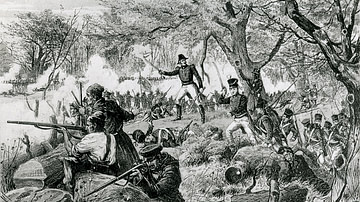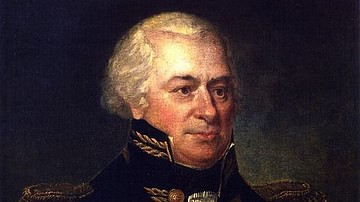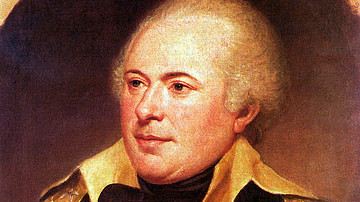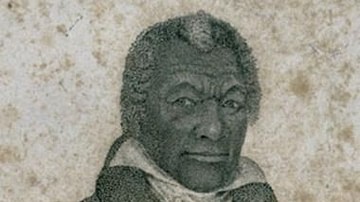The Battle of Crysler's Farm (11 November 1813) was a major battle in the War of 1812. Fought along the banks of the St. Lawrence River, it saw a British and Canadian force defeat a much larger American army, thwarting the United States' attempt to capture Montreal.
Background
By the autumn of 1813, the St. Lawrence Valley had been left largely untouched by the War of 1812, even though the conflict had been raging for over a year. This was partially because the Americans were focused on taking the Niagara Peninsula for political and strategic reasons, but also because David Parish, one of the largest landowners in the St. Lawrence region, had loaned millions of dollars to the Madison administration in the understanding that the US would leave the valley alone. For a while, Parish's bribes paid off, and the only action along the St. Lawrence were minor raids conducted by US Major Benjamin Forsyth and his riflemen, who attacked and plundered the Canadian settlements of Gananoque and Elizabethtown on their own volition. But by mid-1813, as the Americans fumbled their invasion of Niagara, they began to look at the St. Lawrence Valley as an enticing place to open a new front. After all, the river was a major supply line for British Canada, and its capture could allow the Americans to threaten vital Canadian outposts like Kingston or even Montreal.
Such an operation would be led by Major General James Wilkinson, who had recently replaced the outgoing General Henry Dearborn as commander of all US troops along the New York–Canadian frontier. To say that Wilkinson was controversial would be somewhat of an understatement. He was almost universally disliked; Winfield Scott, one of the army's up-and-coming officers, once said that serving under Wilkinson "was as disgraceful as being married to a prostitute" (quoted in Taylor, 281). Indeed, Wilkinson's reputation for treachery stretched back to the American Revolution, when he was implicated in the Conway Cabal, which had unsuccessfully tried to force General George Washington out of command. Since then, Wilkinson had undermined his superior officer, General Anthony Wayne, in the Fallen Timbers campaign of 1794, and had later plotted with Aaron Burr to illegally attack Mexico – when this conspiracy was uncovered in 1807, Wilkinson threw Burr under the bus to minimize his own involvement. To top it all off, Wilkinson was secretly in the pay of the Spanish, having promised to promote their interests in the American West. His detestable reputation stretched well beyond his own lifetime; President Theodore Roosevelt would later say of Wilkinson that "in all our history, there is no more despicable character" (nps.gov).
The fact that a man like Wilkinson had been given such an important command was a testament to the lack of experienced general officers in the US Army. In late August, he arrived at the military camp at Sackets Harbor, New York, where, despite his unsavory reputation, he was cheered by the men. "General Wilkinson has infused new spirit into the troops at this post," reported one captain. "He inspired a degree of confidence in every officer and soldier that I never saw equaled" (quoted in Taylor, 279). The reason for this outpour of jubilation was because the soldiers were in desperate need of hope – under the sluggish leadership of their previous commander Dearborn, they had suffered defeat after defeat and, moreover, were undersupplied and poorly trained, lacking enough officers to properly drill them. What was worse was that they were suffering from disease caused by their tainted food supply; for weeks now, the men had been subsisting on rotten meat, stagnant water, and bread that was found to have been mixed with bits of soap, lime, and even fecal matter. By September, 700 officers and men were incapacitated by illness, and a month later, that number had doubled. The men, therefore, hoped that this change in command would lead to a change in fortune and would save them from their wretched condition.
Shortly after his arrival in Sackets Harbor, Wilkinson met with US Secretary of War John Armstrong, Jr., to concoct a plan. While it was agreed that Wilkinson would lead his 8,000-man army down the St. Lawrence River, the two men disagreed as to their target; Armstrong preferred an attack on Kingston, which housed the main British naval base on Lake Ontario, while Wilkinson advocated for the riskier – yet more glorious – assault on Montreal. The successful capture of Montreal, Wilkinson argued, would sever the British supply line and cut the Canadian provinces in two. Armstrong ultimately relented, viewing the plan with a great deal of optimism. "If our cards are well played," he told Wilkinson, "We may renew the scenes of Saratoga" (quoted in Taylor, 283).
The Campaign Gets Underway
The plan put together by Armstrong and Wilkinson required a two-pronged attack; while Wilkinson's main army descended the St. Lawrence, another 4,000-man army, under Major General Wade Hampton, would create a diversion by marching north from its current position at Lake Champlain to advance along the Richelieu River. Eventually, the two forces would link up for the final push toward Montreal, where they would vastly outnumber the paltry garrison of British and Canadians that had been left to defend the city. There was, however, a glaring problem with this plan: Hampton intensely disliked Wilkinson and flatly refused to take orders from him. Communication between the two men had to pass through Armstrong, an arrangement that did not offer a promising start to the expedition.

Hampton's army was the first to get moving, marching out of its camp at Lake Champlain on 19 September. It soon arrived at Four Corners, a town on the Chateauguay River just south of the border with Lower Canada where Hampton was instructed to wait until Wilkinson's army could get underway. But Wilkinson, dealing with a rapidly increasing number of sick men and grappling with poor logistics, was slow to get started. Indeed, it took his men 19 days to simply load their boats with provisions, a task that the frustrated contractor's agent insisted could have been done in only five. Finally, on 17 October, Wilkinson's army left Sackets Harbor in 300 bateaux and other small watercraft, setting sail for Grenadier Island at the mouth of the St. Lawrence. The next day, Hampton, who had been waiting at Four Corners for nearly a month by this point, was given permission to move out as well.
Chateauguay
Hampton's delay had allowed the British and Canadians time to cobble together a small militia force to oppose him. 460 French Canadians, led by the daring Lt. Colonel Charles de Salaberry, had taken up a defensive position along the road Hampton was likely to take; Salaberry had constructed a log barricade sandwiched between the Chateauguay River to the east, and the swamplands to the west. On the evening of 25 October, Hampton arrived at the Canadian position but was undeterred, since he had the numerical advantage. He dispatched 1,000 men under Colonel Robert Purdy to move around the barricade and get behind the Canadian line; the next morning, Hampton would order a frontal assault while Purdy attacked from behind, a maneuver that would envelop the Canadians and, hopefully, compel their surrender. But unfortunately for the Americans, Purdy's men soon became lost in the darkness, stumbling through dense woods and treacherous swamps. At dawn, they were detected by Canadian sharpshooters, who began taking shots at them; exhausted and confused as to where the bullets were coming from, Purdy's men panicked and began firing at one another.
Hampton, meanwhile, could hear the distant crack of musket fire and assumed that Purdy had begun his attack and was in the process of trapping the enemy. He therefore ordered his men to begin their frontal assault on the barricade at 10 a.m.; as they surged forward, these American troops came under heavy fire from the Canadian skirmishers and were soon forced to fall back. Purdy, whose men had regrouped enough to engage the Canadian militia, had nevertheless failed to time his assault with Hampton's and was also forced to retreat. The Battle of the Chateauguay was over; Hampton had lost 23 killed, 33 wounded, and 29 missing, while the Canadians lost 2 dead, 16 wounded, and 4 missing. Though it had been little more than a skirmish, the engagement completely demoralized Hampton, who decided to withdraw back to Four Corners to await further orders. Thus, one-half of the US invasion had already been defeated. Wilkinson's army was on its own.
Moving Down the St. Lawrence
Unaware that Hampton had been defeated, Wilkinson's flotilla entered the St. Lawrence River on 2 November. By now, Wilkinson himself had contracted the dysentery that was afflicting his men. The general was soon confined to his bunk, plying himself with whiskey and opium to ward off the symptoms. To make matters worse, the American flotilla soon discovered that it was being followed; on 3 November, a cluster of British gunboats under Commander William Mulcaster opened fire at the American ships before being chased off by their artillery. However, Mulcaster's gunboats soon returned and continued to bite at the Americans' heels as they slowly made their way downriver. Between fits of delirium, Wilkinson tried to keep morale up, telling his men that once they reached Montreal "our artillery, bayonets, and swords must secure our triumph or provide us honorable graves" (quoted in Taylor, 283). There was, however, still 150 miles (240 km) to go, with the flotilla crawling along at only 10 miles (16 km) a day.
On the night of 7 November, the American boats successfully bypassed the British outpost of Prescott, losing only two killed and three wounded to a British cannon in the process. This success was marred by news of Hampton's defeat, which left Wilkinson rattled; on 9 November, he held a council of war, in which his officers reluctantly agreed to continue the campaign, even without Hampton's support. Around this time, Wilkinson sent Major Benjamin Forsyth and his riflemen ashore, to chase off Canadian militiamen who had been taking shots at the American boats. Forsyth – who had raided the St. Lawrence Valley earlier in the war – exceeded his orders by plundering the farms and houses of noncombatants, leading one British officer to write to Wilkinson to protest the "system of rapine and plunder of the property of the peaceful and unoffending inhabitants which has marked the progress of the American army" (quoted in Taylor, 284). Needless to say, Forsyth's conduct did not endear the invaders to the local populace.
By this point, British Lt. Colonel Joseph Morrison had managed to scrape together around 900 men to harry the American invasion. Morrison's men were mostly British regulars from the 49th and 89th regiments; while the 89th had recently arrived in North America, the 49th had seen action in most of the major battles in Niagara and knew how to fight the Americans. Wilkinson knew he had to chase Morrison's soldiers off before he could continue his advance down the river. On 10 November, he disembarked 2,100 soldiers under the command of Brigadier General John Parker Boyd – Wilkinson was still too sick to lead the attack himself and decided to stay on the boat. That night, Boyd set up his headquarters at Cook's Tavern while the British were camped about 2 miles (3 km) away on a farm owned by John Crysler, a captain in the Dundas County militia.
Battle
Dawn on 11 November proved cold and rainy, as Morrison formed his men up on Crysler's Farm. He arranged them in an echelon, or diagonal, formation, covered by an advance line of Canadian Voltigeurs (skirmishers) and Native American allies. On this open field, Morrison hoped to fight a European-style battle, utilizing the discipline and uniformity of the British regulars against the individualistic fighting style of the Americans, which favored sheltering behind trees and rocks. Boyd, meanwhile, commanded two brigades: Brigadier General Leonard Covington's 3rd Brigade sat on his left flank, while Brigadier General Robert Swartwout's 4th Brigade was on the right.
Fighting broke out on the river shortly after dawn, as Mulcaster's gunboats opened fire at the American boats anchored near Cook's Tavern. However, the battle did not begin in earnest until the middle of the afternoon, when Boyd finally ordered an assault. Lt. Colonel Eleazer W. Ripley's regiment, part of Swartwout's brigade, led the attack; crossing mud-churned fields, it drove back the Canadian Voltigeurs and approached the British left flank, anchored by the red-coated regulars of the 89th. Now, it was time for Morrison to put the famed British discipline to the test. He ordered a series of parade-ground maneuvers, enabling the 89th to wheel around in time to meet Ripley's regiment as it emerged from the trees. Then came an exchange of volleys; the American soldiers fired at will, but the British unleashed their volleys in unison, sounding like "a tremendous roll of thunder" (quoted in Berton, 621). Ripley's men were soon forced to withdraw.
Next came General Covington's brigade, moving through wheatfields to strike the British right. According to legend, Covington mistook the battle-hardened 49th Regiment ahead of him as Canadian militia, leading him to grow cocky. "Come, lads," he shouted to his troops, "let me see how you will deal with these militiamen!" (quoted in Berton, 622). The Americans charged forward and were met with a devastating rolling volley from the British regulars. Covington was mortally wounded; his second-in-command was killed moments later. Having lost their key officers at this critical moment, the American brigade panicked and fled, abandoning their dead and wounded beneath the gathering cloud of musket smoke.
On the left flank, Boyd was trying to goad his men into another charge but to no avail. The momentum having petered out, he decided that the safest course of action was to order a retreat. It was at this point that the American artillery finally got into position, and was now used to cover the retreating infantrymen. These guns managed to inflict some last-minute casualties on the British, leading Morrison to order a counterattack to capture them. All but one of the cannons were saved by a unit of US Dragoons which beat back the British counterattack and helped remove the guns from the field. With that, the Battle of Crysler's Field ended in a British victory. American losses amounted to 102 killed, 237 wounded, and 120 captured, while the British lost 31 killed, 148 wounded, and 13 missing.
Aftermath
Though the defeat at Crysler's Field was disheartening, it did not necessarily spell an end to the campaign. Indeed, after Boyd's defeated troops re-embarked on the boats, the American flotilla pressed on, moving down through the Long Sault Rapids. But on 12 November, the day after the battle, Wilkinson received more bad news: Hampton had withdrawn further and moved his army all the way back to Plattsburgh, New York, which meant that he would be unlikely to rejoin the campaign. Wilkinson now had to face his grim reality: with his men rapidly sickening and dying, a recent defeat to demoralize the troops, and a Canadian winter quickly setting in, it seemed that the campaign was doomed. After his officers agreed that the situation was hopeless in another council of war, Wilkinson ordered a retreat.
The American flotilla sailed up the Salmon River, a tributary that brought them to the small community of French Mills on the New York side of the border. Believing that he would renew the campaign come spring, Wilkinson decided to winter here, ordering his men to set up camp in this area that was essentially wilderness. There were 230 miles (370 km) of roads connecting French Mills to the nearest supply depot at Plattsburgh, which were soon inaccessible with the onset of winter. Before long, hunger and cold caused 2,000 more men to fall sick, with 216 dying in December alone; funeral dirges became so common that Wilkinson banned them to not further demoralize the men. Before long, it became clear that Wilkinson's army was in no condition to launch a new campaign, and in February 1814, he was ordered to withdraw. Half of the army was sent to Sackets Harbor, the other half to Plattsburgh. Wilkinson was soon removed from command and court-martialed for negligence, although he would ultimately be acquitted when the government was unable to provide enough witnesses.
With the defeat at Crysler's Farm and the subsequent winter at French Mills, the St. Lawrence campaign came to an end. No American army would make another incursion into the valley, which became a hotbed for smugglers, bringing contraband items across the border. As historian Pierre Berton puts it:
Fortunately, this brief explosion…marks the last military excursion down the great river. For John Crysler and his neighbors, the war is over. In spite of James Wilkinson's hollow boast that the attack on Montreal is merely suspended and not abandoned, the St. Lawrence Valley will never again shiver to the crash of alien musketry.
(626)











